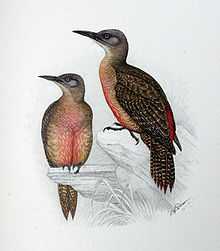Ground Woodpecker
| Ground Woodpecker | |
|---|---|
 | |
| In South Africa | |
| Conservation status | |
| Scientific classification | |
| Kingdom: | Animalia |
| Phylum: | Chordata |
| Class: | Aves |
| Order: | Piciformes |
| Family: | Picidae |
| Subfamily: | Picinae |
| Genus: | Geocolaptes Swainson, 1832 |
| Species: | G. olivaceus |
| Binomial name | |
| Geocolaptes olivaceus (Gmelin, 1788) | |
The Ground Woodpecker (Geocolaptes olivaceus) is one of only three ground-dwelling woodpeckers in the world (the others are the Andean and Campo Flickers). It inhabits rather barren, steep, boulder-strewn slopes in relatively cool hilly and mountainous areas of South Africa, Lesotho and Swaziland and has yet to be recorded outside of Southern Africa. It is the largest woodpecker in the region, reaching 30 cm in length. It usually goes about in pairs or small parties and is best located by its loud, raucous 2-note call (chik-ree, chik-ree) with head-swinging. It often peers over or around rocks at intruders. It breeds in spring and early summer (August to November), and the nest is in a tunnel excavated by the bird itself in the vertical bank of a stream or watercourse.

It is to be found in a broad swath running from south-west to north-east, from the Cape Peninsula and Namaqualand to Mpumalanga. Its diet consists mainly of ants with their larvae, pupae and eggs. These are extracted from dead wood or between rocks, using its long, sticky tongue. Usually 3 glossy white eggs are laid in a chamber at the end of the tunnel.
References
- ↑ BirdLife International (2012). "Geocolaptes olivaceus". IUCN Red List of Threatened Species. Version 2013.2. International Union for Conservation of Nature. Retrieved 26 November 2013.
- Roberts' Birds of Southern Africa - 6th edition (John Voelcker Fund, 1993) ISBN 0-620-17583-4
External links
- Ground Woodpecker - Species text in The Atlas of Southern African Birds.
- Picidae - Nashville Zoo
